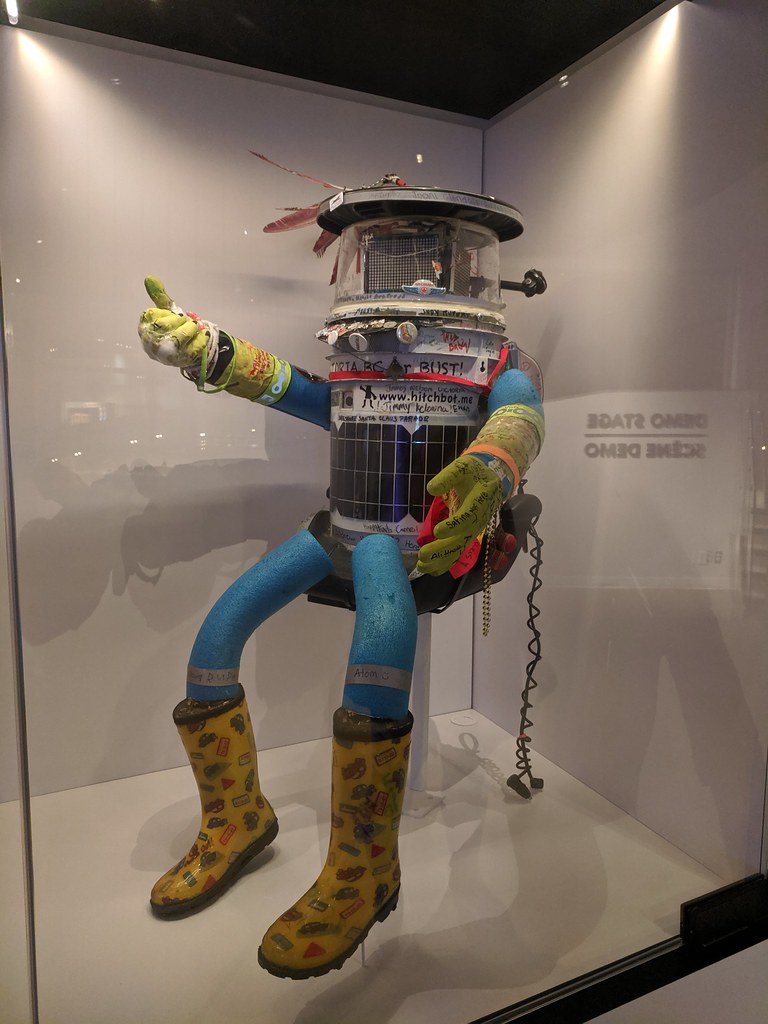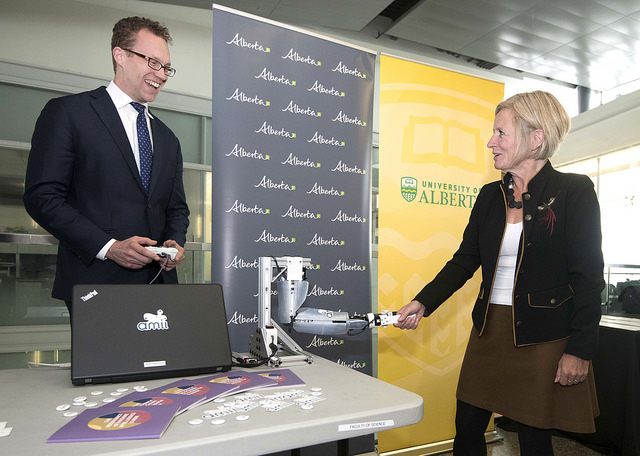Robotics is the branch of engineering that concerns robots: reprogrammable, multifunction manipulators designed to move objects and complete tasks through a variety of programmed motions. The field includes the conception, design, manufacture and operation of such machines. Robotics overlaps with a variety of other electronic and engineering disciplines including artificial intelligence (AI), bioengineering, computer science, mechatronics (the engineering of both electrical and mechanical systems) and nanotechnology. In the late 20th century, Canada distinguished itself in the field with the development of the Canadarm for space missions. Despite the challenges of competing in the international market, Canadian companies, institutes and researchers are now world leaders in the development of AI applications for robotics.

Background
Myths and legends suggest that human beings have conceived of machines that could perform tasks normally reserved for the living. With the development of precision metalworking in the Middle Ages, craftsmen in various cultures began to design self-operating machines (also known as automata) that could perform limited imitations of some human behaviours. (See also Artificial Intelligence.)
The word robot was first used by the Czechoslovak writer Karel Capek in 1921 in a play entitled R.U.R. (Rossum’s Universal Robots). The play is a satire on mechanized society. In the play automatons created to serve humankind go out of control with disastrous consequences.
In 1940, the term appeared in the short story “Robbie” by science fiction author Isaac Asimov. With his 1950 novel I Robot — mainly a compilation weaving together earlier stories (including “Robbie”) — Asimov influenced many of the directions and concepts of modern robotics.
The same year “Robbie” was published, the patent for the first industrial robot was granted to engineer Willard L. G. Pollard for a spray-painting machine. American engineer Joseph Engelberger (1925–2015) is widely regarded as the father of robotics in North America. His company, Unimation, introduced the robotic arm to automobile manufacturing in 1961. (See also Automotive Industry.)
History of Robotics in Canada
Well before robots were used in Canadian industry, colonists brought examples of automata created by European craftsmen. One such device, a mechanical doll created by Léopold Lambert around 1890, is preserved in the McCord Stewart Museum’s collection in Montreal.

One of the first industrial robots to be placed in full operation anywhere in North America is reported to have been in a candy factory in Kitchener, Ontario, in the early 1960s.
Perhaps Canada’s best-known contribution to robotics is the Canadarm. A manipulator able to withstand the harsh radiation in space, it was first used by the crew of the NASA space shuttle Columbia in 1981. On subsequent missions, astronauts used it to remotely construct what would eventually become known as the International Space Station (ISS).
The Canadarm derived from technology developed by the Toronto-based engineering firm Dilworth, Secord, Meagher and Associates (DSMA Atcon) in the 1970s. DSMA Atcon had developed a robot with shielded electronics able to load fuel into Canadian-built CANDU reactors without subjecting engineers to the high radiation levels found within operational reactors. (See also Nuclear Power Plants.)
The next generation of the Canadarm, the Canadarm2, was launched to the ISS in 2001. Canadarm2 has attached and disassembled various ISS modules. It can also dock and undock manned and unmanned cargo modules, capture and release space shuttles, and guide the positioning of astronauts during space walks.

The company behind Canadarm2, formerly MacDonald, Dettwiler and Associates (as of 2024 MDA SPACE), is developing Canadarm3. The arm is Canada’s contribution to NASA’s Lunar Gateway, or Gateway,— a moon-orbiting space station.

Canadarm3
An artist’s concept of Canadarm3, Canada’s robotic system for Gateway, a station in orbit around the Moon.
(courtesy Canadian Space Agency, NASA)
Contemporary Uses of Robots in Canada
Contrary to the popular science fiction images of robots, real robots are typically industrial manipulators: computer-controlled arms and hands. They are common in the automotive and manufacturing industries, where their uses normally include arc welding, spot welding and spray painting. They also transport materials in factories and hospitals in addition to performing tasks too unsafe or repetitive to interest humans. As they replace workers in an increasing number of functions, robots have been blamed for growing unemployment.
Assembly Line at the Oshawa Truck Assembly Plant
The cabs of General Motors pick-up trucks move through a completely automated robotic welding operation on the assembly line at the Oshawa Truck Assembly Plant in Oshawa, Ontario, 26 October 2007.
(photo by Norm Betts/Bloomberg via Getty Images)
The dangerous environments in which robots explore and operate include deep space, deep sea and underground mines. Mining robots are automated vehicles typically used for accessing dangerous places, exploring, digging and loading and transporting materials.
Robots are also used beyond manufacturing, logistics and exploration. For example, several museums around the world have experimented with robotic tour guides. Robots can also be used to prepare and serve food, although such applications are still rare in the Canadian restaurant industry.
Did you know?
In the summer of 2014, two Canadian professors and their research teams sent a hitchhiking robot (called hitchBOT) on a journey across the country. By creating hitchBOT, the researchers aimed to explore the interaction between humans and technology.

Robots are expected to proliferate in the coming decade, driven in large part by home robotics (e.g., vacuum cleaners), autonomous cars and the growth of interconnected “Internet of Things” applications (see also Computers and Canadian Society).
Current Robotics Research in Canada
Although carried out by a relatively small number of researchers, current Canadian robotics research in universities, industry and government laboratories is highly regarded. Montreal is generally considered a world-class centre of excellence in robotics and AI. Toronto is almost as well regarded. Both cities owe their prominence to the highly educated local workforce and large local concentrations of academics who encourage funding partnerships between Canadian universities and international tech firms.
The willingness of various government agencies to fund such partnerships has been a key component of Canadian success in the field. The public-private science and innovation model expands fundraising capabilities beyond traditional academic communities by allowing the private sector to partner with government. Prime Minister Jean Chrétien’s Liberals first outlined the federal government’s commitment to supporting public-private partnerships in their 1994 science and technology review. Shortly afterwards, it became federal policy. Because public-private partnerships have traditionally focused on large infrastructure programs and investment in physical assets, the Canadian focus on research and development is relatively unique.
Challenges of Commercial Robotics in Canada
Canada’s leadership in the research and development aspects of robotic technologies does not necessarily lead to commercial domination. Of the top 21 industrial robotics companies in the world in 2018, not one was based in Canada, although several had Canadian branch offices. The lack of intellectual property and legal protections for Canadian inventions makes it easier for well-funded international organizations to co-opt Canadian inventions and export them for their own purposes.
For example, in 2017, the chairman of Google holding company Alphabet publicly thanked Prime Minister Justin Trudeau for Canada’s publicly funded AI innovations, which the company uses “throughout [its] entire business” as a “major driver of [its] corporate success.”
AI and Modern Robotics in Canada
Today, the development of new AI applications is the largest source of growth in the Canadian robotics industry. AI-based software applications increasingly act as controlling mechanisms for manufacturing and robotics equipment. They allow the machinery to learn new processes that increase the equipment’s flexibility and usefulness.
Canada has funded and supported AI pioneers such as Yoshua Bengio (of the Université de Montreal and the Montreal Institute for Learning Algorithms(MILA)), Yann LeCun (of New York University and director of AI research at Facebook) and Geoffrey Hinton (winner of the 2024 Nobel Prize in Physics and and chief scientific advisor of the Vector Institute). (See also Nobel Prizes and Canada.)
One example of public-private partnership in AI research is the IBM Innovation Space in Ontario. The $54 million initiative funded by IBM, the Ontario Centres of Excellence and the Ontario government aims to drive innovation in healthcare, natural resources and financial services. Launched in 2016, ythe space provides networking, funding, mentorship, industry expertise and support services to innovative local AI and robotics start-ups.
Sun Life, Adobe, LG and TD Bank are also involved in this area, as is the Canadian Institute for Applied Research (CIFAR). In 2017, the Canadian government picked CIFAR — in partnership with MILA, the Alberta Machine Intelligence Institute (Amii) and the Vector Institute — to lead the $125 million Pan-Canadian Artificial Intelligence Strategy. Given the increasing integration of AI and robotics, the strategy’s plan to boost AI in Canada stands to benefit the country’s robotics industry.


 Share on Facebook
Share on Facebook Share on X
Share on X Share by Email
Share by Email Share on Google Classroom
Share on Google Classroom












